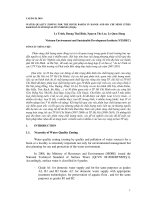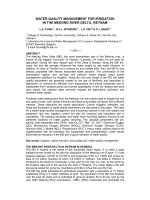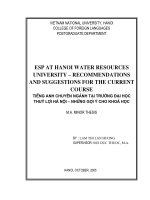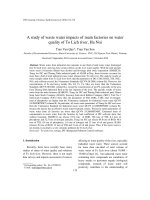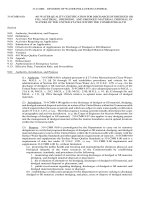water quality zoning for the river basins
Bạn đang xem bản rút gọn của tài liệu. Xem và tải ngay bản đầy đủ của tài liệu tại đây (221.18 KB, 12 trang )
1
CAFEO 28, 2010
WATER QUALITY ZONING FOR THE RIVER BASINS IN HANOI AND HO CHI MINH CITIES
BASED ON WATER QUALITY INDEXES (WQIs)
Le Trinh, Duong Thai Binh, Nguyen The Loc, Le Quoc Hung
Vietnam Environment and Sustainable Development Institute (VESDEC)
TÓM TẮT TIẾNG VIỆT:
Phân vùng chất lượng nước đóng vai trò rất quan trọng trong quản lý môi trường lưu vực
đầu nguồn và kiểm soát ô nhiễm nước. Bài báo tóm lược nội dung phương pháp và kết quả thu
được từ các đề tài "Nghiên cứu phân vùng chất lượng nước các sông, hồ trên địa bàn các thành
phố Hồ Chí Minh và Hà Nội , đề xuất các giải pháp sử dụng hợp lý và bảo vệ " do Lê Trình và
các CTV Viện Môi trường và Phát triển Bền vững thực hiện trong các năm 2007-2010.
Dự
a trên: (i) 10 lựa chọn các thông số đặc trưng điển hình cho chất lượng nước của sông
và hồ tại Hà Nội (và TP Hồ Chí Minh); (ii) các kết quả phân tích, quan trắc chất lượng nước
(iii) các mô hình tính chỉ số chất lượng nước thiết lập cho riêng cho vùng TP. Hà Nội và TP Hồ
Chí Minh đã được phân loại chất lượng nước qua 50 điểm quan trắc trên các con sông chính ở
Hà Nội (sông Hồng, Cầu, Đuống, Nhuệ, Cà Lồ, Tô Lịch) và các h
ồ chính (Hồ Tây, Hoàn Kiếm,
Bảy Mẫu, Trúc Bạch, Ba Mẫu, ...) và 50 điểm quan trắc ở TP Hồ Chí Minh trên các sông Sài
Gòn, Đồng Nai, Nhà Bè, Soài Rạp, Lòng Tàu, Cần Giuộc, Chợ Đệm, các kênh rạch 5 mức phân
loại chất lượng nước ở tất cả các sông, kênh rạch, hồ đã được xác định: Loại I (very clean - ô
nhiễm rất nhẹ); loại II (tốt, ô nhiễm nhẹ); loại III (trung bình, ô nhiễm trung bình); loại IV (ô
nhiễm nặng) loại V (ô nhiễm rất n
ặng). Kết hợp kết quả của việc phân loại chất lượng nước tại
các điểm quan trắc và kết quả của phương pháp đo chất lượng nước liên tục từ thượng nguồn
đến hạ lưu các con sông, hồ đề tài đã triển khai thực hiện việc phân vùng chất lượng nước cho
mạng lưới sông, hồ của TP Hồ Chí Minh (2007-2008) và TP Hà Nội (2008-2010). Từ những kết
qu
ả thu được của việc phân vùng chất lượng nước, các đề tài nghiên cứu này đã đề xuất các
biện pháp khác nhau để sử dụng nước và kiểm soát ô nhiễm ở các luu vực sông tại hai TP này.
1. INTRODUCTION
1.1. Necessity of Water Quality Zoning
Water quality zoning (zoning by quality and pollution of water sources) for a
basin or a locality is extremely important not only for environmental management but
also planning for use and protection of the water environment.
In 2008, the Ministry of Resources and Environment (MORE) issued the
National Technical Standard of Surface Water (QCVN 08:2008/BTNMT)[1].
Accordingly, surface water is classified in 4 grades:
- Grade A1: for domestic water supply and for the same purposes as grades
A2, B1 and B2 Grade A2: for domestic water supply with appropriate
treatment technologies; for preservation of aquatic flora , and for the same
purposes as grades B1 and B2
2
- Grade B1: For watering and irrigation or other uses that have the same
requirements of water quality as grade B2.
- Grade B2: for waterway and other uses that need only water of poor quality.
The determination that a basin or a river section in a province is of which grade,
A1, B1 or A2, B2, is the responsibility of the People Committee (PC) of that
province/city (from viewpoints of water use planning). The scientific and practical
background for water quality classification and zoning under QCVN 08 –
2008/BTNMT necessitate the application of a classification system based on water
quality index (WQI) in accord with characteristics of water resources in that locality or
basin.
With a good zoning in hand, policy makers, governmental agencies, sectors and
companies and the community can clearly determine:
- Which zones (or sections) in the river basin meeting requirements of water
quality to be used for domestic water supply (water intaken for waterworks)?
- Which zones (or sections of the rivers) meeting requirement of water quality for
safe and profitable aquaculture.
- Which zones (or sections of the rivers) can supply safe and good water for
irrigation?
.
- Which zones are suitable for building up qualified facilities of water sports and
tourism
.tourism?
- Which zones cannot be used for the purposes above and priority should be
given to pollution treatment and control.
In addition to adorning the landscape and the culture of Hanoi and Ho Chi Minh
City, their systems of rivers, lakes and lagoons have a very important role to play in
domestic water supply, irrigation, aquaculture, climate conditioning, receiving and
ababolism
assimilation of waste matters, and transport. Nevertheless, as a result of
speedy growth of population, urbanization and industrialization, water quality of rivers
and lakes in these two big cities of Vietnam has and will deteriorate quickly.
That circumstance urges the assessment of pollution on every river section,
every lake or lagoon for proper surface water use zoning, orientation and protection of
the water environment and that in turn is an incentive for studies on water quality
zoning for Hanoi and Ho Chi Minh City. Two projects with the similar title
“Study on
water quality zoning for the rivers, canals and lakes, proposal of measures for reasonable
use and protection”
decided by the authorities of the cities of Ho Chi Minh and Hanoi
were implemented by Le Trinh and his colleguages in the Vietnam Environment and
Sustainable Development Institute (now, the Vietnam Institute for Environmental
Science and Development – VESDEC) in a durationof 2007-2010As presider
[2,3].
1.2. Water Quality Model
3
Water environment assessment neeedsneeds a system of indexes for
quantification and comprehensive description of various chemical, physical and
biological components of a water source as well as the significance of every parameter
for a specific use. One of those indexes is Water Quality Index (WQI). WQI is an
index computed from specific water quality parameters with a predetermined method
(or mathematical formula).
The WQI model was recommended and applied the first time in the USA in
1965 – 1970
and1970 and now, it is applied widely in many states [4-6]. Various WQI
models have been studied and applied in many nations such as India, Canada, Chile,
England, Wales, Taiwan, Australia and Mala
yxiaMalaysia. WQI is considerdconsidered
an effective tool for environmental managers in water quality monitoring, water source
management, environmental protection efficiency evaluation, water pollution control,
and for communties
communities and policy-makers to obtain information of water
pollution, etc. WQI is also convenient for application of information technology in water
quality management and mapping.
In vietna
Vietnam, WQI systems were modeled by Nguyen Van Hop (Hue
University [7-8] based on the Bhavarva model (India) for applying to rivers in Quangtri,
Thuathienhue (2005). Le Trinh has developed the WQI models of the NSF (USA) and
Bhargava (India) for water quality zoning of rivers and canals in Ho Chi Minh City
(2008) [2] and Cantho (2009) [9]. Those results are valuable in water quality assessment
and classification as well as pollution zoning of basins for water use planning and
pollution control planning.
1.3. Study area and contents of water quality zoning of Hanoi City
1.3.1. Study area
The study site is consisted of all rivers flowing over the (former) Hanoi City, i.e.
the Red, Duong, Cau, Calo, Nhue, Tolich – Kimnguu, - Lu and large lakes in the urban
area and suburbs.
13.2. Study contents
For accurate water quality zoning of Hanoi City, the project has developed the
contents as follows:
- Assessment of the existing conditions and prediction of the changes in pollution
levels of rivers and lakes in accordance with the deve
lopment plan of Hanoi City.
- Additional investigation and analyses of water pollution at 50 sites, together with
measurements of water quality changes along the rivers of 300 km in total in two
points of time, the rainy season (2008) and the dry season (2009).
- Selection of typical water quality parameters of Hanoi (10 selected parameters).
4
- Research to establish two WQI models suitable for the rivers and lakes in Hanoi:
the WQI – HN1 model simulating the NSF (USA) method and the WQI – HN2
model similating
simulating the India method.
- Water quality zoning of rivers and lakes based on the obtained models and
analytical data of water quality.
- Preparation of digital water quality zoning maps.
- Study and proposal of water use options for every river section and lake in Hanoi.
- Study and proposal of measures for pollution control and water protection of
rivers and lakes in Hanoi.
2. OUTPUTS
2.1. WQI – HN1 model
The formula of WQI – HN1 can be expressed in two forms:
- Weighed sum:
WQI
A
– HN1 =
∑
n
wiqi
1
.
- Weighed product:
WQI
M
– HN1 =
∏
n
wi
qi
1
Based on expertise, the project has seletedselected 10 parameters to put in the
computation model as follows:
1. BOD 6. Suspended solid
2. DO 7. Total P
3. T. Coliform 8. Turbidity
4. pH 9. Fe
5. Total N 10. Grease and oil
5
2.2. WQI – HN2 model
In order to build up the WQI – HN2 model suitable for rivers and lakes in
Hanoi city, the project has researched and developed the original model of Bhargava
[5]. Accordingly, the computation of WQI for rivers and lakes at first requires
identifying
:
(i) Water uses.
(ii) Water quality parameters selected to accompany those uses.
(iii) Sensitive function (Fi) corresponding to the paramaters
parameters selected.
(iv) WQI – HN2 is computed with formula:
1/n
n
i
i=1
WQI = F x 100
⎡⎤
⎢⎥
⎣⎦
∏
Where F
i
:
-
Value of the sensitive function of parameter i, in the range of 0.01
÷
1
-
Fi is found from the sensitive function of parameter i
-
n: number of selected parameters of water quality (n = 3
÷
5,
depdending
depending on water use)
k
i
i=1
WQI
WQI =
k
∑
(1)
In the computation of the general WQI
TQ
– HN2 (water quality index for multi-
uses), it is accepted that the importance of all water uses is the same and thus the
coefficients of WQI
i
– HN2 for every water use in formula (1) is equal to 1. The
parameters selected based on expertise are shown in
Table 1
:
Table 1: Water quality parameters selected for specific uses, applicable to rivers
and lakes in Hanoi City
No. Specific use Selected parameter n
1 Direct contact
DO, TSS, BOD
5
, grease and oil,
T.Coliform
5
WQI – HN2
WQI
i
– HN2
WQI
TQ
– HN2
